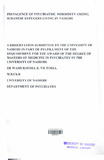| dc.description.abstract | One per cent of the world's populations, 50 million people, are currently uprooted. In Africa there are 6 million refugees. In the past decade the worldwide refugee population has increased tenfold and all indicators show that this number will continue to rise. Kenya hosts 374,000 refugees, mainly from Ethiopia, Somalia and Southern Sudan. Several studies of disaster victims found that PTSD, major depressive disorder, generalized anxiety disorders, and panic disorders were identified commonly by most of the studies. Refugees could be at excess risk of psychiatric morbidity because of forced migration, traumatic events, and resettlement in unfamiliar environments. The relevant epidemiological evidence is, however, generally sparse, scattered, and apparently conflicting, and its interpretation has been complicated by the use of different sampling and assessment methods.
Objective: To establish psychiatric morbidity and substance use disorders among Sudanese refugees living in Nairobi.
Method: The study was a cross-sectional descriptive study. The Study instruments were Mini International Neuropsychiatric Interview-PLUS (M.I.N.I-PLUS), M.I.N.I screen which was used to screen clients before the M.I.N.I-PLUS was administered, a researcher designed social demographic and clinical questionnaire and alcohol, smoking and substance involvement screening test (ASSIST).
Data analysis: There was double data entry and analysis using SPSS version 16 and inferential analysis. Results are presented in form of narratives and tables.
Results: The overall prevalence of psychiatric morbidity among Sudanese refugees residing in Nairobi was 56.2% (n=135). 66.7% (n=90) out of the 135 patients diagnosed with a psychiatric morbidity had a single diagnosis. The remaining 33.3% (45) patients with psychiatric illness had comorbid psychiatric illnesses. The most commonly diagnosed psychiatric morbidities among the study participants were post-traumatic stress disorder and major depressive episodes at prevalence rates of 24.1% (n=58) and' 20.4% (n=49) respectively. These two diagnoses'. prevalence was significantly higher than for each of the remaining diagnosis. The other frequent psychiatric morbidities among the refugees included generalized anxiety disorder accounting for 5.8 % (n=14), dysthymia 5.4% (n=13) alcohol dependence, 3.8% (n=9) and khat dependence 3.8% (9).
Limitations: The sampling method was not random. A cultural validation study was not done.
Conclusion: This study provides important information on the prevalence of psychiatric morbidity among the urban Sudanese refugees. Consistent with other studies, it confirms that psychiatric morbidity is indeed higher in refugees than in general populations
Recommendations: More studies on the prevalence of psychiatric morbidity among refugees living in camps in Kenya are required to build evidence base in order to guide mental health policy decisions for the displaced populations. Advocacy for the mental health of refugees and displaced people should be done. All health care workers in humanitarian relief work should be well trained on identification of mental disorders in order to enhance quick diagnosis and correct management. | en_US |

